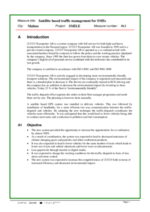About the project
Within the project, a set of measures was implemented with the aim of developing intelligent, sustainable and inter-modal urban transport systems allowing citizens to live an active life without using a car.
The project aimed to improve urban air quality, quality of life, health, safety and security through the promotion of bio-fuels, clean vehicles and intelligent door-to-door travel choices.
The objective was to halt the current trend towards increased car use, promote sustainable alternatives and stimulate the efficient and clean distribution of goods in the cities.
The CIVITAS SMILE cities illustrated some of the typical problems facing historic medium-sized cities in the European Union and accession countries, indicating a high level of transferability of the project results.
CIVITAS SMILE involved 27 partners, who implemented 51 demonstration measures all aimed at lowering hazardous emissions from city traffic. With impacts stretching well after the project’s conclusion, the project fostered a modal shift towards public transport, cycling and car sharing.
CIVITAS focused primarily on urban transport. However, it is often very difficult to consider urban transportation in isolation from the wider regional perspective. This was reflected both in the formation of the SMILE partnership, which included a range of regional authorities and one regional transport authority; and also in the measures, many of which had a regional rather than purely urban perspective.
Implementing sustainable mobility
Examples of the 51 measures included:
- In Malmo, gas-powered buses were introduced in the urban bus fleet, along with the complete range of bio-fuel refueling infrastructure. Buses could either be refueled using bio-fuel or directly from the national gas grid.
- In a second step, the proportion of bio-fuel was increased in Malmo. By the end of the project, 50 percent of the gas required for public transportation was derived from renewable sources.
- CIVITAS SMILE provided co-funding to retrofit vehicles to comply with the requirements of the Norwich low-emission zone. As part of the project, particulate traps and special catalytic converters were installed to ensure that vehicle emissions meet the nitrogen oxide and particulate emissions criteria of the zone.
- Eco-driving training was provided to 90 bus drivers who regularly work on services passing through the Norwich low-emission zone.
- Research was carried out into biodiesel and the impact of nitrogen oxide levels within the Norwich low-emission zone.
- In Suceava, the project provided co-funding to invest in new public transport vehicles and their subsequent conversion to liquefied petroleum gas.
- In addition to rolling stock modernisation, the project also financially supported investments into public transport priority measures in Suceava.
Project results
CIVITAS SMILE activities often resulted in achievements that reached beyond the implementing cities’ boundaries. For example, Malmo and a consortium of other Swedish cities helped define a Swedish standard for low-emission zones. The project also recognised the importance of sustainable urban mobility plans and called for new national legislation to provide a supportive policy framework for them.
Political backing was shown to be a key success factor in delivering the innovative sustainable transport measures within SMILE. This had major implications even on day-to-day project implementation, such as releasing municipal staff for eco-driving training. Clear and unambiguous direction from senior staff and politicians was therefore found to be crucial to give priority for sustainable mobility.
CIVITAS played an important role in pushing the boundaries of innovative measures in the cities, either speeding up the implementation of new ideas or providing an opportunity for the testing of innovative measures.
The key driver for such demonstrations was to ensure that successful measures had a business plan in place so that the benefits could be exploited and introduced into the mainstream.
This required long-term planning, such as the approach taken at the Norwich freight consolidation centre, where the measure was set up in such a way as to ensure that the ongoing financial liability is shared with a private sector operator.
The project demonstrated that improvements to public transportation can generate additional income. In Suceava, a new regulatory regime was introduced for private minibuses that resulted in a new market opportunity for the public transport company, while at the same time generating additional income for the municipality, which it has been able to invest in purchasing new buses.
Cities
Fast Facts
February 2005 - January 2009
Project duration
27 partners
Project partners
€34,175,203
Project funding
51 measures
Measures implemented
Latest
Knowledge Bank
Mobility solutions
Thematic areas
Collective passenger transport & shared mobility
Clean & energy-efficient vehicles
Integrated & inclusive planning
- Spatial planning / land-use planning
- Multimodal hubs
- Cooperation of policy fields and institutional stakeholders
- Sustainable Urban Mobility Plans - SUMP

















